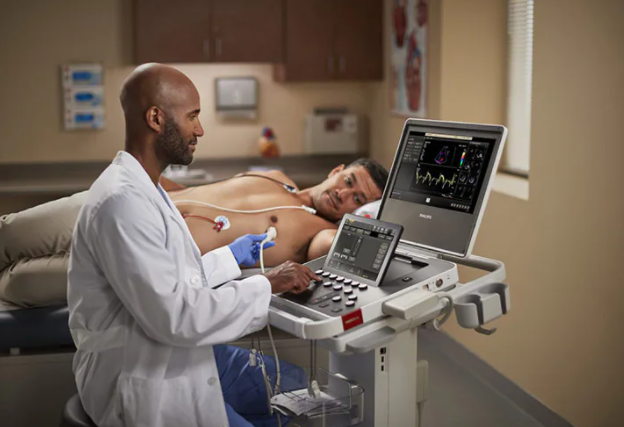
Image courtesy of Philips
Compared to a marked slowdown of demand during the pandemic, the ultrasound systems market is making up for lost time and is expected to continue experiencing significant growth.
A myriad of market reports from industry analysts consistently identifies four key drivers of increasing demand, specifically in the United States: 1) rapid increasing of the geriatric population; 2) rising prevalence of cancer; 3) increase in cardiovascular diseases; and 4) the fast pace of ongoing technological advancements available in ultrasound systems. Each are collectively creating opportunities for the market growth.
Ultrasound Market Segments
Based on technology, the market is segmented into diagnostic ultrasound and therapeutic ultrasound. In a market synopsis released in November 2022, Emergen Research reported that the global therapeutic ultrasound market size reached $1.93B in 2021 and is expected to reach $4.07B in 2030 registering a CAGR of 8.5%.
The diagnostic ultrasound market is expected to reach $10B by 2030, according to a Global Market Insights Inc. report. The industry is anticipated to register 4% CAGR between 2022 and 2030, chiefly owing to the rising incidence of chronic diseases. In its October 2022 report, GMI wrote, “Pathbreaking technological advancements in the development of ultrasound systems will also bolster the usage of this technology across a variety of clinical applications.”
It added that the hospital segment accounted for over 49.5% share of the diagnostic ultrasound market in 2021. Hospitals are increasingly adopting novel diagnostic technologies, such as ultrasound imaging, to provide an effective diagnosis for complex diseases which is vital, as they also serve a growing number of emergency patients who require urgent scanning to determine a diagnosis. Diagnostic ultrasound is increasingly used for examining kidneys, abdomen, gall bladder, liver, pancreas and spleen.
In its most current summary forecast of the ultrasound systems market, published in June 2022, Reports and Data analysts noted, “Prevalence of chronic diseases including cancer, reproductive organ disorder, renal stones, muscle lacerations and spleen problems will further support the market growth.” Also notable, according to the Reports and Data outlook, was the introduction of two applications which have elevated the level of traditional medical procedures: Doppler ultrasound in vascular imaging, and 3-D/4-D ultrasound in oncology.
Its analysts zeroed in on the prevalence of chronic diseases as a primary basis for the increasing demand for minimally invasive diagnostic and therapeutic imaging. The authors noted, “The diagnostic segment is further segmented into 2-D, 3-D, 4-D and Doppler ultrasound, while therapeutic ultrasound is segmented into focused ultrasound and shockwave lithotripsy. Diagnostic ultrasound is expected to account for significant share in the market owing to increasing usage of 2-D ultrasound in women’s health, availability of medical reimbursement for diagnostic procedures, and ongoing technological advancements in the field of diagnostic ultrasound imaging.”
Ultrasound Technology at RSNA22
During the Radiological Society of North America Scientific Assembly and Annual Meeting (RSNA22), top ultrasound system vendors reported notable updates, a few shared here. See ITN’s extensive RSNA22 coverage online, and in the January/February 2023 issue for additional updates on product innovations in this growing sector.
Philips announced the global launch of its next-generation compact portable ultrasound solution at RSNA22. The company noted the new Compact 5000 Series aims to bring the diagnostic quality associated with premium cart-based ultrasound systems to more patients. Designed for portability and versatility without compromising image quality or performance, the Compact 5000 Series facilitates “first-time-right” ultrasound exams. Recently receiving FDA 510 (k) clearance and pending CE mark, the newly-launched system joins Philips’ expanded ultrasound family, with the added benefit of EPIQ Elite and Affiniti workflow commonality and lifetime value.
Samsung showcased leading product updates, including the V7 ultrasound system, a new endocavity transducer and new real-time on-device AI solutions, during the 2022 RSNA meeting. The new on-device AI solution for ultrasound, known as HeartAssist, which can enhance the diagnosis and examination process, was also on display. Samsung’s new V7 ultrasound system provides a wide array of clinical applications, including a range of on-device Intelligent Assist features, such as BiometryAssist and UterineAssist, which enhance both the patient and user experience.
View ITN's Ultrasound Systems Comparison Chart here
Related Ultrasound Imaging Content:
Ultrasound Systems Market Trends
2021 Review: Transcranial Doppler Ultrasound Imaging
Stroke Scans Could Reveal COVID-19 Infection
Lung Scans for Stroke Patients Could Provide Earlier COVID-19 Detection
PHOTO GALLERY: How COVID-19 Appears on Medical Imaging
Digital Health Devices Used at Point of Care May Improve Diagnostic Certainty
Insights on the Worldwide Handheld Ultrasound Imaging Devices Industry


 May 07, 2024
May 07, 2024 








